Introduction
Bambara nut (Voandzeia subterranean (L.) thousar) belongs to the Plantea of the family of Fabaceae and sub family of Faboidea. The crop is a legume species of tropical African origin.1 It was discovered in Yola, Northern Nigeria by Dalziel in 1901 as a wild plant.2 It is currently receiving attention from many researchers because it grows well in poor soils, resistible to diseases and produces very high yield compared to other crops.3,4 Bambara nut is reported to contain between 16-24% crude protein and serves as an important source of protein in the diets of a large percentage of the population in Africa and Asia, 5-7 particularly the under privileged people who cannot afford expensive animal protein. Bambara groundnut is a well balanced food with a similar caloric value to cereal grains.8 it is eaten as snack in immature stage as boiled or grilled or roasted matured dry seeds. The matured dry seeds are often milled into flour and used in the preparation of akpekpa, moimoi, okpa, akara , canned bambara nut.9-11 Recent increase in utilization of bambara groundnut as food for both human and livestock has led to increase in prices and relatively scarce crop. Thus the utilization of bambara nut as a composite flour in the production of food for human consumption is on the rise.This will reduce pressure on bambara nut and ultimately serve as impetus to farmers for production and utilization of other crops for flour production.
Cassava (Manihot esculenta crantz) is a perennial woody shrub of euphorbiacae family grown as an annual. Cassava is a major source of low cost carbohydrate for over 600 million people in Sub Saharan Africa, South America and Asia.12 Cassava is very cheap and a staple food in many Nigerian homes for human consumption and income generation.13 Cassava roots contain about 25 to 30% starch but deficient in nutrients like protein, minerals and vitamins, 14 which abound in legumes. Cassava is used majorly to produce traditional foods like fufu, lafun, chips, gari, ruam nahan, kuesi alogo, pupuru and industrial starch. 14,15 Therefore the use of Cassava as composite flour in akpekpa production would diversify its use, enhance its nutritional value, combat hunger, and bring down the cost of akpekpa made from 100% bambara nut and ensure food security in African continent.
Soybean (Glycine max) is a leguminous vegetable of the pea family that grows in the tropical, subtropical and temperate climates. It contributes protein, fat, vitamins, and minerals in the diet of people in developing countries. It is an important oil seed that contains about 44.6% crude protein and is eaten in processed form. High protein energy foods have been developed from soyabeans. It is reported as a food that contain all the nutrients that the body needs, and its use in akpekpa preparation will enhance the nutritional value of the product which is consumed by all age groups.
“Akpekpa” is a traditional steamed gel product prepared from Bambara nut (Voandzeia subterranean L. thouaars) flour . Other ingredients include pepper, onions, salt, palm oil and water, which is wrapped in leaves, Thaumatococcus daniellii, Ikya-kon and placed in hot water to boil. The leaves give akpekpa its characteristic taste and unique flavor. It is a delicacy and well cherished food similar to okpa, 12 eaten by over five million people including children and adults in North central Nigeria particularly among the Tiv people.
The process of akpekpa production from bambara nut and composite flours to my knowledge have not been documented, this work will therefore provide standardized procedures for making akpekpa. The competing demand on bambara nut for human consumption and animal feed13, and consequent high prices has led to the utilization of composite flours from soyabeans, cassava, maize, cocoyam, guinea corn for preparing akpekpa. Moreover recent studies have shown that soyabeans promote good health and prevent diseases such as breast cancer, prostate cancer, atherosclerosis, cardiovascular disease13, thus its use in akpekpa production will enhance the health of the consumers. In order to ensure a safe, nutritious and quality akpekpa that would benefit hungry and malnourished persons in Nigeria, there is need to study the proximate, functional and sensory properties of the flours and product.
The objective of this work is therefore to study the proximate and functional properties of the flours and sensory properties of the product from the blends of Bambara nut, cassava and soybean flours.
MATERIALS AND METHODS
Source of raw materials:
Bambara nut (Voandzeia subterranean L. thouaars) and soybean (Glycine max) were purchased from Wurukum market in Makurdi, Benue state, North central Nigeria. Cassava (Manihot esculenta) was purchased from the university farm. The chemicals and reagents used were of analytical grade.
Sample preparation
Bambara nut flour: The flour was prepared according to the method described by Olapade and Adetunji .16 The Bambara nut seeds were cleaned and sorted to remove all foreign materials such as dust, dirt, small branches and immature seeds. Then 200 grams clean seeds were soaked in cold water for 8 hours, after which it was dehulled using plate mill with 6mm clearance between the plates and dried at 650 for 48 hours in air draught drier (Mermmet, Germany) to a moisture content of 10%. The dried sample material was milled into powder using a hammer mill and sieved through 0.8mm sieve size. The sample was packed in high density polyethylene and stored at room temperature for further analysis.
Cassava flour: This was prepared using the method described by IITA .17 Fresh cassava roots were peeled with knives, washed manually and cut into two or three halves depending on the length of the tuber. The halves were sliced longitudinally to facilitate the removal of the central fibre. The sliced roots were washed with clean water and grated using a mechanical grating machine. The ground cassava mash was spread out on a tray and dried in a solar dryer at 60±20C for 5 hours and milled with a hammer mill and the flour passed through a sieve of 0.8mm and packaged in a black polyethylene bag stored at room temperature until when used.
Soybean flour: The flour was processed by the method of Kordyles.18 Soybean seeds were cleaned and sorted manually to remove unwanted foreign materials such as dust, dirt and immature seeds. The clean sorted seeds were soaked in cold water for at least two hours, then it was strained and boiled for 25 min . It was dried in a mechanical dryer for 10 hours at 100-120o and the chaff removed during winnowing. The dried seeds were milled with hammer mill and sieved through a sieve of 0.8mm diameter. The resultant flour was wrapped in black polyethylene bags and stored in air tight containers at room temperature until use.
Blending of flour: The bambara nut, cassava and soybean flours were blended to give three samples while 100% bambara nut coded as sample A served as control. Sample B consists of 80% bambara and 20% cassava flour, sample C has a ratio of 80% bambara nut and 20% soyabeans flour and sample D was made up of 15% cassava and 15% soybeans and 70% bambara nut. The flours were mixed in a Philips blender (HR2811 model) at full speed for 5min. The flour samples were packed in labeled airtight containers and kept at room temperature for analysis.
Proximate composition of the flour blends:
The moisture content, protein, crude fat, ash and crude fibre contents of the Bambara nut, cassava and soyflour blends were determined using the standard methods of AOAC.19 Total carbohydrate was calculated by difference.
Functional properties of the flour blends:
Water and oil absorption capacities: Water and oil absorption capacities were determined according to the method described by.20 This was expressed as gram of water or oil absorbed or retained per gram of sample.
Bulk density: This was determined using the method described by.21 About 2.5 g of sample was filled in a 10 ml graduated cylinder and its bottom tapped on the laboratory bench until there was no decrease in volume of the sample. The volume was recorded.

Least gelation capacity: This was determined by the method described by.22 2%, 4%, 6%, 8%, 10%, 12%, 14%, 16%, 18%,and 20%, (w/v) of sample in 5ml distilled water in test tube were heated for 1 hour in boiling water. The test tubes were further heated for 2 hours at 400 and least gelation capacity was determined as the concentration that would not fall when the test tubes were inverted.
Foaming capacity (FC): This was determined by the method described by 23. About 2 g of sample was blended with 100 ml distilled water in a Kenwood blender. The suspension was whipped in an ace homogenizer (NSEIAM-6) at 1600rpm for 5 minutes. The mixture was poured into a 250ml graduated cylinder and the volume was recorded after 30 seconds. The foaming capacity was expressed as percentage increase in volume using the formula:

Preparation of akpekpa: The paste for akpekpa preparation was made from reconstituted flours.
About 200g of the flours each was hydrated with 60ml water which was thoroughly mixed. The other ingredients blended with the paste are; 10g fresh pepper, 10g onions, 2g mono sodium glutamate seasoning, 20ml palm oil and 1g salt. The Kenwood food blender was used at speed 3 for 4min.The mixture was then dispensed into Thaumatococcus daniellii leaves, popularly called ikya kon by the Tiv speaking people of North central Nigeria. These leaves give the product its characteristic taste and flavor and must be used in preparing akpekpa.
Sensory evaluation: The akpekpa samples were coded and presented to ten member panel of judges who are familiar with the product for sensory evaluation. The panelists scored the colour, flavor, taste, texture and overall acceptability of the akpekpa using a nine point hedonic scale, where 9 indicates extremely like and 1 extremely dislike.24
Statistical analysis: All the data were subjected to analysis of variance (ANOVA) as described by.25 The means were then separated with the use of Duncan’s multiple range test using the statistical package for the social sciences, SPSS 19.0 software.
RESULTS AND DISCUSSION
Proximate composition: The result for the proximate composition of the flour blends are presented in Table 2. The ash content of the flour blends ranged from 3.39 – 3.5% with 100% Bambara nut having the ash content of 3.39% . The data showed that there was no significant (p<0.05) difference between all the samples. The ash content however increased from 3.39 – 3.5% and 3.39-3.49% with addition of 20% cassava flour and soyflour respectively. The increment could be attributed to the flours that were incorporated. Many researchers reported different values of 3.10, 3.88, 4.19 and 4.4 percent as ash content of bambara nut flours.26-29 These values are indication of minerals that are contained in the flours and the differences could be due to the different species and other environmental factors where the bambara nuts are grown. The moisture content ranged from 8.95 – 10.01%. Sample A, 100% bambara nut flour had the highest moisture content of 10.01% and the flour blends showed no significant difference (p<0.05) between samples A, B and C. Sample D which contained 70% bambara nut and 15% each of cassava and soyflours respectively was significantly different from other samples. The low moisture content range of 8.95- 10.01% would enhance the keeping quality of the flours. The result is similar and within the range reported by oyeleke et al and Piyarat. 26, 28 The values may be attributed to the species used. The protein content of the flours ranged from 13.12 – 17.50% with sample C consisting of 80% bambara nut and 20% soyflour having the highest value of 17.5%. This may be attributed to the high protein content in soy beans which is reported to be in the range of 40-48 % crude protein.30 Similar results were reported by Enwere and Hung,31 and yusuf et al.32
The results obtained for the fat content of the flour blends ranged from 4.04-6.90% with sample C (80% bambara nut and 20% soy flour) having the highest value of 6.90%. Sample A, 100% bambara nut flour contained 5.75% fat which increased to 6.90% with the addition of soy flour. This is similar to the fat content of 5.8% in bambara nut reported by Oyeleke et al 26 and Yusuf et al 32. This may be attributed to the fact that soybean is an oil seed. The crude fibre content of the flour blends showed no significant difference (p<0.05) between all the samples. The results ranged from 1.40 – 1.50 with 100% Bambara nut having 1.45. Other workers have reported higher values of crude fibre as 4.88-5.48%, 33 4.93-6.49% 34 and 2.07-4.05% 35 for bambara nut flours. The lower fibre content in this work could be attributed to the variety of the crops and the soil type where they were planted.
The carbohydrate content of the flour blends ranged from 61.12-67.88%. The result showed significant difference (p<0.05) between samples A, C and D, but there was no significant difference between samples B and D. This is similar to the work reported by yusuf et al. 32 This implies that akpekpa would be a source of energy to the consumer.
Functional Properties: The results for the functional properties of the flour blends are presented in Table 3. The results ranged from 0.69 – 0.71 g/cm3 with 100% Bambara nut flour having the highest bulk density. The results for bulk density of the flour blends showed that there is no significant difference (p<0.05) between all the samples. This result is comparable to that obtained for germinated pigeon, fermented sorghum and blanched cocoyam flour blends.36 This could be explained that the addition of cassava and soyflour to bambara nut flour did not alter the bulk density significantly at the quantity used.
The foaming capacity of the blends revealed significance differences (p<0.05) between all the samples. The result ranged from 11.77 – 23.77 ml/g with 80% Bambara nut and 20% cassava flour having the least foaming capacity. Foam is produced in a liquid when air is introduced resulting in formation of bubbles. The differences in the foaming capacity of the flours may be attributed to the different composition and nature of the protein fractions. It may also be explained on the basis of presence of globular proteins which makes denaturing of the surface difficult.37 This is similar to the values reported for flaxseed flours by38 but higher than the result for red bean, wheat and haleem wheat flours by Ashraf et al. 39
Oil absorption capacity result revealed that there was no significant difference (p<0.05) between the samples. The result ranged from 2.26 – 2.73 g/g with 100% Bambara nut having the oil absorption capacity of 2.35g/g. The least oil absorption capacity was observed in sample B consisting of 80% bambara nut and 20% cassava flour. This result is higher than the data for flaxseed flours,38 and lower than the values for red bean, wheat and haleem wheat flours by. 39
The low Oil absorption capacity seen in sample B could be due to presence of hydrophilic group from the cassava flour incorporated. Protein concentration and their conformational properties in foods also influence fat absorption.40
Water absorption capacity showed significant difference (p<0.05) between sample A and other samples, but samples B, C and D showed no significant difference. The results ranged from 1.93 – 2.15 g/g with 100% Bambara nut having the least water absorption capacity. The water absorption capacity was found to be similar to the result obtained by. 38 the low water absorption seen in 100% bambara nut could be due to high proportion of hydrophilic group and polar amino acid on the surface of the protein molecules, 40 and the increase may be due to the water binding properties of the flour blends.
The Least gelation capacity of samples A-D was determined as 4% (w/v). This shows that there is no significant difference (p<0.05) between the samples. A higher value of gelation capacity for raw jackfruit (16%),22 and a lower value of 2% for boiled mung bean and 4% for raw undehulled mung bean flours,42 have been reported.The differences in the least gelation capacity may be due to varied ratios of the flour such as carbohydrates, lipids and proteins.
Sensory evaluation: The result of sensory evaluation of akpekpa produced from Bambara nut, cassava and soyflour blends is presented in Table 3.
The result for colour showed significant difference (p<0.05) between samples A, B and D, but no significant difference (p<0.05) between B and C. The result ranged from 7.00 – 7.93 with 100% Bambara nut having the brightest colour. The colour for the other samples were all rated high. The result for flavour and taste revealed significant difference (p<0.05) between all the samples. The results ranged from 6.20 – 7.80g with 100% Bambara nut having the highest flavour. However all the samples were scored higher than five which is the minimum score acceptable on a 9 point hedonic scale. The high score of akpekpa from 100% bambara nut could be attributed to the fact that the panelists are familiar with the flavor of akpekpa as compared to others.
The result for texture showed that there was no significant difference (p<0.05) between all the samples. This could be that the texture of the product was not affected at the level of flours incorporation used.
The result of general acceptability showed that there was no significant difference (p<0.05) between samples A and B but there was significant difference between samples Cand D. It can be deduced from the result that samples A and B are most acceptable followed by C and D. This work has demonstrated that acceptable akpekpa can be produced from Bambara nut flour, cassava flour and soyflour blends. The production of akpekpa from flours of these crops would diversify their use, provide affordable and nutritious food for the teeming population of hungry people and enhance food security on the African continent.
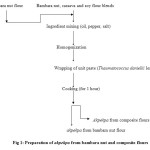 |
Fig 1: Preparation of akpekpa from bambara nut and composite flours Click here to View figure |
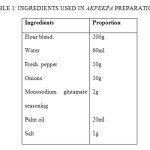 |
TABLE 1: INGREDIENTS USED IN AKPEKPA PREPARATION Click here to View table |
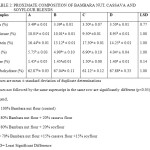 |
TABLE 2: PROXIMATE COMPOSITION OF BAMBARA NUT, CASSAVA AND SOYFLOUR BLENDS Click here to View table |
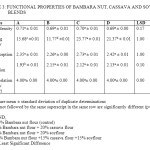 |
TABLE 3: FUNCTIONAL PROPERTIES OF BAMBARA NUT, CASSAVA AND SOYFLOUR BLENDS Click here to View table |
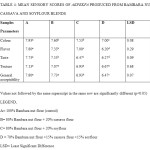 |
TABLE 4: MEAN SENSORY SCORES OF AKPEKPA PRODUCED FROM BAMBARA NUT, CASSAVA AND SOYFLOUR BLENDS Click here to View table |
Acknowledgement: Appreciation is due the Department of Food Science and Technology for provision of technical support and facilities for carrying out the research.
REFERENCES
- Kay, D.E., Food Legumes. Crop and product digest No.1 London:TPI p.142(1979).
- Goli, A.E. Proceedings of workshop on conservation and improvement of bambara groundnut 14-16 November, 10-16 (1995).
- Gwekwerere, Y. Proceedings of workshop on conservation and improvement of bambara groundnut 14-16 November, 84-86 (1995).
- Hepper, F. N. Field crop abstract, 23, 1-6 (1970).
- Olomu, J.M. Monogastric animal nutrition, principles and practice, Jachem publication,320 (1995).
- Temple, V.J. and Aliyu, R.Bioscience Research Communication,6, 51-54,(1994).
- Aremu, M.O., Olaofe, O and Akintayo, E. T., Pak. J. Nutr., 5 , 34-38 (2006).
CrossRef - Barimila, ,I.S., Achiraohu,S.C., Yibatama, I.and Amadi, E.N. J. Sci. Food and Agric. 66, 143-146(1994).
- Obizoba, I.C., Nutrition Report International, 27, 709-712 (1983)
- Linnemann, A.R. Tropical crops communication, 16 (1990).
- Swanevelder, C.J. National Department of Agriculture Pretoria, Republic of South Africa, Government printer,pp6 (1998).
- Olapade, A.A., Ozumba, A. U., Solomon, H.M., Olatunji, O. and Adelaja, S.O. Nig. Food Journal, 23, 144-147 (2005).
- Koledoye, G.F.,Deji, O.F., Owombo, P.T. and Toromade, O.G. Agriculture and food science, 1, 1, 26-32 (2012)
- Oyegbami, A, Oboh, G, and Omueti, O. African J. Food Agric. Nutrition and Development. 10, 2, 2176-2186, (2010)
CrossRef - International Institute for Tropical Agriculture, cassava in tropical Africa,a reference manual, 259-262, (1995)
- Olapade, A. and Adetuyi, D.O. Nig. Food Journal, 25,2, 150-157 (2007)
- IITA, IITA publication, ISBN 97813101698. 23, (1990)
- Kordyles, J.M. Processing and Preservation of Tropical Foods. Macmillan publishers, London, 67-80 (1990)/li>
- AOAC, Official Methods of Analysis.15th ed. Washington, D.C (1990).
- Okezie, B.O. and Bello, A.B.J. Food Sci.53, 450-454(1998).
CrossRef - Onwuka, G.I.Food Analysis and Instrumentation: Theory and Practice. Naphthali Prints, Lagos, Nigeria, 133-137(2005)
- Sathe,S.K., Deshpande, S.S. and Salunkhe, D.K.J. Food Sci. 47:503-509 (1982).
CrossRef - Coffmann, G.W. and Garcia, V.V. J. Food Tech. 12, 473-477(1977)
CrossRef - Ihekoronye, R.I. and Ngoddy, P.O. Integrated Food Science and Technology for the Tropics, Macmillan Publishers, London, 259-262(1985).
- SAS(statistical Analytical System), (1999)
- Oyeleke,G.O.; Afolabi, O. and Isola, A.D. Journal of Applied Chem. 2,4,16-19 (2012)
- Onimawo,J.A., Momoh, A.H. and Usman, A. Plants food for Human Nutr. 53, 153-158(1998)
CrossRef - Mune,M.M.A., Mbome, L.I. and Minka, S.R. Pakistan Journal of Nutrition.6,6, 660-664 (2007).
CrossRef - Piyarat,S. Songklanakarin J.Sci. Technol. 30,1, 51-56 (2008).
- Amarteifio and Moholo. Journal of Food Composition and Analysis. 11, 329-332 (1998).
CrossRef - Riaz, M.N. Cereal Foods World. 44, 136-139 (1999).
- Enwere, N.J. and Hung, Y.C.Intl. J.Food Sci. Nutr., 47:469-475 (1996).
CrossRef - Yusufu, A.A., Ayedun, H. and Sanni, L.O. Food Chemistry, 111, 277-282 (2008).
CrossRef - Akande, K.E.; Abubakar, M.M.; Adegbola, T.A.; Bogoro, S.E.; Doma, U.D.and Fabiyi, E.F. Continentsl J. Food Science and Technology.3:8-13 (2009).
- Olanipekun, B.F.; Otunola, E.T.; Adejuyitan, J.A.; Adeyanju, J.A. Transnational J. Science and Technology. 2,9, 77-86 (2012).
- Aremu, M.O., Olaofe, O. and Akintayo, E.T. Journal of Applied Sciences 6,9:1900-1903(2006)
CrossRef - Okpala, L; Eric,O.and Emelem, U. Food Science and Nutrition. 1, 1: 8-14 (2013)
CrossRef - Graham, D.E. and Phillips M,C. The Conformation of Proteins at the Air-Water Interface and Their Roles in Stabilizing of Foams. Academic Press, Lodon,237 (1976)
- Shahzad, H.; Faqir, M.A.; Masood, S. B. and Munir, A. S. Sarhad J. Agric. 24,4: 649-654 (2008).
- Ashraf, S. Saeed, S.M.G., Sayeed, S.A. and Ali, R. Int. J. Agric. Biol., 14:365-370 (2012)
- Odoemelam, S.A. Pakistan Journal of Nutr. 4, 6:366-370 (2005)
CrossRef - Akaerue, B.I. and Onwuka, G.I. Journal of Agricultural and Veterinary Sciences. 2,1-28 (2012)

This work is licensed under a Creative Commons Attribution 4.0 International License.





